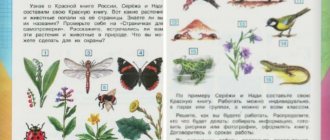Colors in our lives
Appearance of colors:
The history of colors probably began with the advent of man. Cave people drew on the stones what surrounded them: running animals and hunters with spears. Primitive drawings made with charcoal and sanguine (clay) have survived to this day. The earliest examples of well-preserved prehistoric paints have been discovered in caves in southern France, Spain and South Africa. These were pure oil paints made from a mixture of animal fat and natural pigments such as ochre, manganese ore (manganese dioxide), iron oxide and chalk.
Archaeologists were lucky enough to find not only the ancient artist’s palette, on which remains of paint were preserved, but also small flat millstones and pestles intended for grinding colored soils, as well as cups for diluting paints. Cave paintings of the same time, discovered in Africa and Europe (Spain, France), amaze modern people with their perfection. (Appendix No. 1)
Our ancestors used a rich palette of earthy colors: yellowish, greenish, and reddish.
Sometimes, before painting with paints, they engraved the design. When studying rock paintings in the Sahara, they found that in the paintings the penetration of dyes into the sand rock reached 1 mm, while no traces of a binder were found. This is explained by the fact that paints diluted in water were almost instantly absorbed by sandstone.
However, in other cases, substances capable of forming a film were already used to prepare paints: casein was found in the Fezzan paintings, and ox blood was found in the paintings found in South Africa. Scientists have come to the conclusion that this activity was necessary for the Neolithic race, as it was a form of knowledge. Man, not having at that time the ability to generalize phenomena, was forced to resort to figurative and emotional means. In addition, rock art conveyed tribal traditions.
Thus, already in distant prehistoric times, colors played a big role in human life: even then their social significance became apparent - the function of an information transmitter, a cultural function, which is difficult to overestimate in the development of civilization.
The manifestation of the decorative and aesthetic function of paints also dates back to this time. The desire to be more beautiful, to make their difficult life more attractive in the constant struggle for existence is characteristic of representatives of the human race.
Do you know that ancient coal cave paintings were painted with ash and are now turning into dust due to the constant presence of numerous tourists who harm these paintings with their breath. (Note No. 2)
Introduction to paints:
The roots of oil painting go back to the distant past - it appeared long before the famous Van Eycks, with whom many associate the discovery of this technique. This technique best conveyed space, volume and depth of color. For a long time, some paints remained incredibly expensive. This was explained by the fact that the natural pigments included in the paints had high prices. Over time, artificial paints were obtained, which were significantly cheaper than natural ones, but there was one important “but”: they could cause allergies, and often deterioration of health.
Despite the fact that the appearance of paints dates back to prehistoric times, the modern paint industry was created relatively recently.
200 years ago there were no ready-made paints and the ingredients had to be mixed and ground before use.
The very first paints were multi-colored clays: red, white, yellow and blue. A little later, paints began to be made from minerals and plants. A decoction of onion peels, walnut shells, and oak bark gave a brown dye. The bark of barberry and alder, euphorbia plants were yellow, and red dye was obtained from some berries. Various methods of preparing paints were passed down from generation to generation, from artist to artist. Almost every master had his own “secrets”. Interesting and unusual recipes by Russian artists were found in ancient handwritten lists. For durability and plasticity, eggs and milk protein - casein - were added to the paint. Painters soaked finely ground lapis lazuli in sour cabbage soup for 2-4 days. Paint prepared in this way became even more durable and rich. Sometimes saffron and pike bile were mixed to obtain a golden color. Until about the mid-eighteenth century, it was quite difficult for artists to find the right paint and prepare it for use. To get the yellow color of the paint, pigment powders and fats were mixed. Such paints could not be stored for more than a day; when exposed to air, they oxidized and quickly hardened. Working with such paints was also quite difficult because some (most often dark) shades took longer to dry than shades with a high ocher content (lighter and yellow). Many masters had assistants specifically for stirring the paint. Basically, dyes were obtained by grinding and pulverizing various minerals. Moreover, most often by hand. It was very expensive to make really bright and long-lasting paint. For example, ultramarine (a bright blue dye) was obtained from lapis, which could only be brought from Iran and Afghanistan. This mineral was expensive, so it was rarely used. Artists used ultramarine only when the customer agreed to pay for the paint in advance. The purple dye was extracted from the shells of Mediterranean snails. To get 1 gram of paint it took about ten thousand shells! Because it is so expensive, purple is considered the color of luxury, royalty and wealth. Until the nineteenth century, paints were used that were very harmful to health. In 1870, an analysis was made of the effect of paints on human health. Paints that contain lead and arsenic turned out to be toxic. It turned out that very beautiful and bright paint (emerald green) is deadly - dangerous, because... it contains vinegar, copper oxide and arsenic. In ancient times, drawings were made using mineral-based paints, which allows them to maintain their brightness for a very long time. In particular, in the above figures, ocher was used - one of the most common minerals, a product of weathering of feldspars. Ochers are sedimentary rocks; they almost always accompany iron ore deposits. Ocher colors are very diverse, but always have a warm tonality - from pale yellow and golden to red and dark brown, almost black.
As for the area of use of such paints, ocher is so widespread on the planet that it would probably be easier to say who did not use them. I do not have such information, but I can assume that such tribes would have to live in permafrost areas, as well as in high mountain areas. Medieval artists also prepared their own paints by mixing pigment powders and fats.
Thus, we can consider that the appearance of colorful substances was one of the first discoveries. In Russia, the history of colors is studied through icons. (Appendix 3) The earliest paints in icon painting and manuscript painting of the 11th-13th centuries were various ocher and soot - “smoked ink”, blue azure and cinnabar, green yari, white. The icon of Dmitry of Thessaloniki has survived to this day. This icon is over 600 years old and is still in good condition.
The most ancient painted objects are of Chinese origin. Furniture and household utensils have reached us, covered with a layer of paint with great artistry. The oldest traditional product dates back to approximately 200 BC. e. The milky sap from the bark of the lacquer tree was used as varnish. The varnish was given a black or red color using minerals, and later gold dust or stripes of gold were added to it. For rock and wall paintings in Ancient Egypt, earthen paints were used, as well as artificially produced colored oxides and other metal compounds. Ocher, red lead, whitewash, soot, ground copper luster, iron and copper oxides and other substances were especially used.
Plants were used as sources of dyes: alkanna, woad, turmeric, madder, safflower, as well as some animal organisms.
Also, paint is a messy business. Pure shades of minerals, delicate plant juices... and blood, manure, live worms, rotten shellfish. It becomes completely clear why people used to walk around the dyers' quarters a mile away, holding their noses.
Is it possible to make environmentally friendly paints and obtain natural dyes at home? Of course, it is possible and we will try to prove it.
Plants that are familiar to us contain coloring substances, although they are not so bright and not so persistent. Our ancestors often used them.
I study at an art school and there we paint with different paints: watercolors, gouache, oil paints, pastels. These paints can be purchased at any office supply store. Modern artists do just that. But where did artists get paints a long time ago, when there were no stores and they weren’t made in factories? Having studied the materials presented on the Internet and published in magazines and books, I learned that paints can be made from almost everything that surrounds us: flowers, berries, tree bark, earth, clay, tea, coffee, grass, etc...
Types of paints and their differences from each other:
Gouache is a bright water-soluble paint that, when dried, fades a little due to the white it contains, but acquires a wonderful velvetiness. Drawing with gouache is both simple and difficult. Rubens and Picasso painted gouache. (Appendix No. 4)
Watercolor is also a water-soluble paint; it gets its name from the Latin (AQVA) - water, since water is the solvent for these paints. Watercolor can be either bright or softly pale. Its main difference from gouache is that watercolor is transparent, the paper and previously applied layers of paint are visible through it. (Appendix No. 5)
Pastel is paint that is not applied with a brush, and this is part of its appeal for the painter. The fact is that pastels come in the form of special crayons or rimless pencils, so the artist does not need to dip the brush into paint and mix colors on the palette. There are three types of pastels: oil pastels made from pigment with linseed oil, and dry pastels without oil. Levitan, Serov and Degas painted in pastels. Pastel appeared in Russia in the first half of the 18th century. (Appendix No. 6)
Ink is a liquid material made from soot that allows you to draw both fine lines with a pen and broad strokes with a brush. Ink drawings are especially expressive due to the contrast of thin black lines with white paper, the delicacy of the brush marks and the feeling of a certain “understatement”. (Appendix No. 7)
Charcoal is an ancient material used for drawing, but is still one of the most popular. It is great for “quick” drawings and allows you to perfectly convey the artist’s mood. (Appendix No. 
Tempera are suspensions of inorganic pigments and fillers in polyvinyl acetate dispersion with various additions. These are paints mixed with eggs, sometimes called “egg paints”. (Appendix No. 9)
Oil - for their production, poppy, nut or specially processed linseed oil is used. When we say the word “painting,” we usually imagine a picture painted in oil, and this proves that oil, without exaggeration, can be called the main painting material. (Appendix No. 10)
Acrylic is a material that appeared in the 20th century as a product of the development of chemistry, based on acrylic resin. (Appendix No. 11)
Ocher is a natural earth paint. The most ancient pigment, known to prehistoric “painters” - the authors of cave paintings. Like lead white, ocher is widely used in painting to this day. (Appendix No. 12)
Orpiment is a mineral of golden yellow and red (with shades) color. Chemically, both are arsenic sulphide. (Appendix No. 13)
Massicot is the oldest yellow paint, known since the times of Ancient Rome, where it was called artificial sandarac or sandix. (Appendix No. 14)
Cinnabar is mercury sulfide of pure red, red-brown or crimson-red color. It is one of the most famous and most widely used red paints in the past, featuring a deep, dark red color. (Appendix No. 15)
Purple was prepared from the secretion of purple snails and was widely used. (Appendix No. 16)
Lime – (from the Greek “asbestos” - “unquenchable”), a generalized name for the products of firing - limestone, chalk, marble, oyster shells. Whitewash was the main white paint in Egyptian frescoes. (Appendix No. 17)
Chalk is a fine-grained, soft, white limestone, consisting of small fragments and entire calcareous skeletons of marine microorganisms. (Appendix No. 18)
Encaustic is paint mixed with wax, but the recipe for its preparation has been lost. (Appendix No. 19)
Wax – mixed paints. (Appendix No. 20)
Henna and Basma are natural natural dyes. (Appendix No. 21)
Exploration in the world of paints:
The world around us is colorful. Ancient artists looked for material for paints right under their feet. Almost the same dyes (pigments) have been used for centuries. From red and yellow clay, finely grinding it, you can get red and yellow dye, or, as artists say, pigment. Black pigment produces charcoal, white pigment produces chalk, azure blue or green pigment produces malachite and lapis lazuli. Metal oxides also produce green pigments. Since ancient times, plant paints have been used by humans to decorate weapons, clothing and homes. At first it was the juices of bright petals, leaves, and fruits of plants. Then people learned to make special paints from plants. During excavations of Egyptian pyramids, blue fabrics dyed with indigo (a dye from the leaves of the indigofera plant) were found. In Ancient Rus', blue dye was extracted from the root of the knotweed, yellow dye from the roots of horse sorrel, cherry dye from the lichen of the steppe goldfly, and with the help of blackberries and blueberries they dyed fabrics in purple tones. They learned to produce yellow, green and black paints from mantle, and red, yellow and orange from St. John's wort.
Ancient artists obtained yellow pigments from ocher. Another well-known source of yellow is saffron. 8000 flowers yielded about 100 g of dried fiber, from which the pigment was extracted. They not only painted pictures with it, but also painted over cosmetics, wine, rice, and in Rome they added it to baths.
Blue pigment was previously mined from a semi-precious stone - lapis lazuli. From these basic colors, others were obtained by mixing. In rare cases, paint is used dry (in pastels or painting with colored pencils), but in most cases, dry paint is mixed with some kind of liquid. Such liquids are either water, with a certain amount of glue, or gum, or vegetable oil, sometimes with a certain amount of wax and resins. Glue is included in watercolors and gouache. Watercolor is a light, translucent paint that requires dilution with water. The name itself speaks about this.
Oil is part of oil paints; they are the most durable and apply thick strokes to the paper. They are stored in tubes and diluted with a solvent - kerosene or turpentine.
The most ancient ink recipe belongs to the Egyptians - a mixture of soot and oil for writing on papyrus. Red, “court” ink, was made from purple and cinnabar. And the black ones included soot, grape seeds and vines, and bone charcoal. Iron ink, which is still used today, was invented in the 16th century. To make them, alder roots, walnut or oak bark were processed. Since then, many ink recipes have been invented, including “eternal” and even invisible ones. One of the classic European legends says that the world's first paint was black. How to get it? Firstly, for this you can prepare a decoction of the berries and roots of the crow. But there is another way, a simpler one: add iron sulfate to one of the previously obtained decoctions. Almost all of our decoctions contain tannins such as tannin (remember the experiments with tea), and in the presence of ferrous iron salts they turn black.
Dry dye cannot stick to the canvas, so you need a binder that glues and binds the particles of dry dye into a single colored mass - paint. The artists took what was at hand: oil, honey, egg, glue, wax. The closer the pigment particles are to each other, the thicker the paint. The thickness of the paint can be determined by looking at how a drop of honey or an egg spreads, or at a long-drying drop of oil, which does not even combine with water, and when drying leaves a greasy mark.
Different binders produce different paints with different names. After analyzing the literature and articles on the Internet, you can describe how paints are prepared.
First they look for raw materials. It could be coal, chalk, clay, coffee beans, onion peels. Raw materials must be cleaned of foreign impurities. Then the materials must be ground to powder. The raw materials can be ground at home. Ancient artists ground the powder in a mortar and pestle. The resulting powder is the pigment.
Then the pigment must be mixed with a binder. You can use egg, oil, water, glue, honey as a binder. The paint must be mixed well so that there are no lumps. The resulting paint can be used for painting.
Of course, over time, methods for isolating dyes have improved, and the quality of dyes has increased. However, man had to be content with what nature provided for a long time.
To conduct experiments, it is necessary to obtain natural pigments and binders. They are stored in tubes and diluted with solvent, kerosene or turpentine. Paints and varnishes have come a long way from their inception to the present day. Their production technology is improving every day. Paints are valuable because they allow you to obtain both protective and decorative coatings, so the demand for them is growing and growing. This means that the history of colors continues...
Conclusion:
People have been trying to decorate our world for a long time. The appearance of paints and drawing dates back to prehistoric times. The very first paints were coal, chalk, and clay. Then the person noticed that some plants and berries secrete very persistent substances that last a long time and are difficult to wash off with water. Over time, natural ingredients were pushed out and replaced by artificial ones. The color family is diverse: there are acrylic, gouache, tempera, oil paints, etc. But I was interested in getting paints at home. Research work can also be interesting and useful for children who are interested in experiments and experiments, as well as for teachers of chemistry and fine arts.
How to get dyes?
Here are some recipes for making paints:
- 100 grams of blueberries are infused for two days in 100 g of alcohol or 100 g of berries are boiled for thirty minutes in 300 cm3 of water.
- 15 g of finely chopped cherry bark are infused for 24 hours in 50 cm3 of water, then boiled for an hour and filtered. You can infuse 15 g of bark in 50 g of alcohol without boiling.
- Chop fresh mantle roots with a knife, pour into a vessel at the rate of 40 g of roots per 100 g of water and put on fire. Boil for about twenty minutes, then strain through a cloth and evaporate the broth until thick.
- Place the crushed lichen in a glass or test tube and pour in a solution of potassium hydroxide or soda. After three minutes you get good paint;
- Rub 1 red beet through a coarse grater, place in an enamel pan and add water so that the latter covers the beets. Cover the pan tightly with a lid and simmer over low heat for 1 hour. Then drain the liquid, squeeze out the pulp, add a pinch of citric acid to the solution so that the solution does not change color and is brighter, strain, cool.
Finger painting
The finger painting technique was used by Ruth F. Show, around 1932, as she needed to overcome problems that arose in her school. This technique, according to Ruth Shaw's observations, helped the children who attended her school get rid of fears and depression. This technique was later implemented by P. Napoli (1946, 1951).
This technique was used to reveal the basic characteristics of personality. Finger painting made it possible to reveal sincere manifestations of personality, creating conditions for self-expression. Finger painting puts minimal strain on the arm muscles and has no patterns. The drawings always turn out bright and interesting.
Shaw and Lyle argue that finger painting is one of the ways to develop an individual's imagination.
Finger paints are used for finger painting.
These are water-based paints, they wash off clothes very well without leaving any stains. You can paint with such paints not only with your fingers, but also with a brush. It’s just that children are often too young to confidently hold a brush in their hands, so drawing with their hands is a priority in this case. It is worth noting that finger paints do not spread at all, which gives the child the opportunity to paint on any surface, including glass or plastic.
The developmental impact of such paints on a child lies primarily in the development of fine motor skills. He learns to control his fingers, bright colors help this a lot. The child also learns about the world, he sees different colors and understands that he has the opportunity to choose one or another option.
Today, there are several ways to paint with finger paints: painting with your palms, painting with a household sponge, drawing with stamps, using stencils. Painting with finger paints is a preparatory stage for the transition to painting with a brush, it teaches you to feel the boundaries of the sheet, and has a positive effect on the development of imaginative thinking [9] .
The “finger painting” technique allows you to use paints based on natural dyes. Such paints are “edible” and nothing bad will happen if a small amount of them gets into your mouth. Delicious natural ingredients to add to your finger paints:
- for pink color – beet juice;
- for bright orange, choose carrots, orange or tangerine zest;
- green color can be obtained with dill or spinach. Steam the greens in boiling water, and then strain through cheesecloth;
- black currants give a purple color (the best variety is “barberry”);
- brown color can be obtained by adding coffee or chocolate;
- for bright yellowness - turmeric;
- red color can be obtained from: cranberries, lingonberries, cherries, red currants, dogwoods, barberries;
- Raspberries will give a crimson color.






